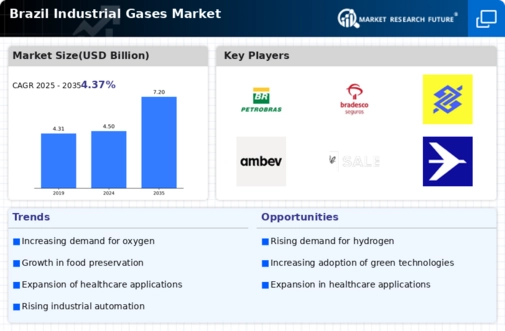The Brazil Industrial Gases Market represents a vital segment within the broader industrial sector, characterized by rapid growth and significant competition among key players. The market has been influenced by various industrial and economic factors, including increasing demand from sectors such as healthcare, manufacturing, and food processing. The industrial gases industry in Brazil encompasses a wide range of gases, including oxygen, nitrogen, argon, and specialty gases, which are critical for numerous applications.
In this competitive landscape, companies are strategically positioning themselves through mergers, partnerships, and technological advancements to gain a larger market share and cater to the specific needs of Brazilian industries. Additionally, environmental regulations and sustainability initiatives are leading firms to innovate and focus on more eco-friendly production methods, significantly shaping competitive strategies in the market.
Linde stands out in the Brazil Industrial Gases Market with a robust presence and a comprehensive portfolio of products and services. The company has successfully established itself by catering to diverse sectors, including healthcare, food and beverage, and metal fabrication. One of Linde's primary strengths lies in its ability to provide customized solutions and a consistent supply of high-quality gases. Additionally, the company's advanced distribution network in Brazil ensures reliable service for its customers, thereby reinforcing its competitive edge.
Linde's commitment to innovation and sustainability enhances its reputation in the market, as the company continually invests in technologies that minimize environmental impact while maximizing efficiency. This focus on sustainability resonates well with Brazilian industries that are increasingly prioritizing environmentally responsible practices.
Messer Group has made significant inroads into the Brazil Industrial Gases Market, leveraging its strong heritage and expertise in the field. The company offers a diverse range of industrial gases, including oxygen, nitrogen, and argon, in addition to specialty gases tailored for various applications across industries. Messer Group's strengths include its dedicated customer service and localized approaches, which allow it to meet the specific needs of Brazilian clients effectively. Furthermore, the company has engaged in strategic mergers and acquisitions that have bolstered its market presence and broadened its product offerings within Brazil.
Through these initiatives, Messer Group continues to enhance its operational capabilities, positioning itself as a formidable competitor in the region's industrial gases landscape. Its focus on innovation and adapting to local market conditions further solidifies its standing among industry peers in Brazil.

















Leave a Comment